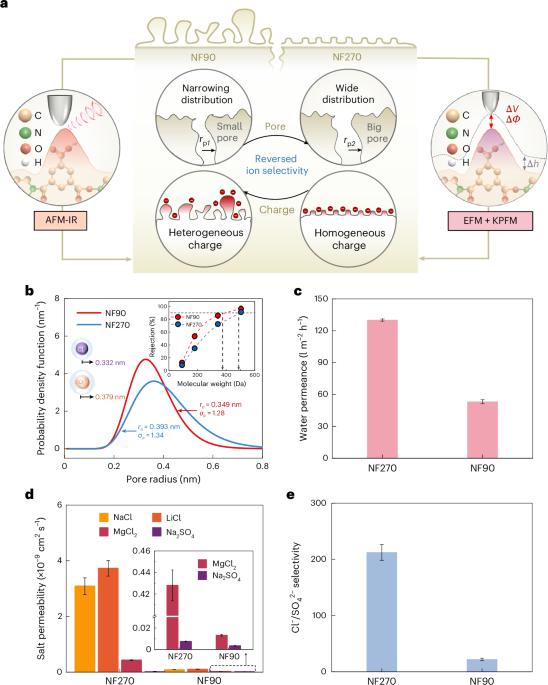Impact of charge homogeneity on ion selectivity in polyamide membranes
IF 24.1
引用次数: 0
Abstract
Ion-selective membranes, crucial for diverse applications such as water purification, brine disposal and resource recovery, rely heavily on the pore architecture and surface charge. Narrowing the pore size distribution (PSD) of the membrane is generally acknowledged to be essential for achieving higher ion selectivity. Here we challenge the conventional emphasis on PSD by introducing an alternative determinant—surface charge homogeneity—drawing inspiration from a counterintuitive relationship between PSD and ion selectivity observed in both commercial and laboratory-made polyamide nanofiltration membranes. By integrating multimodal atomic force microscopy technologies, we visually extracted nanoscale charge maps from three dimensions: surface potential, phase and functional groups. The metrological analysis methodology was originally developed to quantitatively describe the spatial charge distribution. It is demonstrated that nanoscale spatial charge homogeneity plays a crucial role in governing ion selectivity, surpassing the influence of PSD. Based on this perception, we devised the high-selective nanofiltration membranes and modules for the lithium–magnesium mixture separation by using a polyethyleneimine multivariate strategy to program polyamide membranes with stepwise-enhanced homogeneous distribution of electropositive-amine moieties. Our work unveils a unique charge homogeneity-dominated selectivity mechanism and demonstrates the feasibility of developing highly ion-selective membranes by facile nanocharge manipulation, surpassing the need for precise PSD control. The conventional focus on pore size distribution overlooks the role of surface charge homogeneity in ion separation by polymeric membranes. This study proposes a surface charge engineering strategy for fabricating highly ion-selective membranes.

聚酰胺膜中电荷均匀性对离子选择性的影响
离子选择膜在水净化、盐水处理和资源回收等多种应用中至关重要,它在很大程度上依赖于孔结构和表面电荷。缩小膜的孔径分布(PSD)通常被认为是实现更高离子选择性的必要条件。在这里,我们通过引入另一种决定因素——表面电荷均匀性,挑战了对PSD的传统重视,从商业和实验室制造的聚酰胺纳滤膜中观察到的PSD和离子选择性之间的反直觉关系中获得灵感。通过集成多模态原子力显微镜技术,我们从表面电位、相和官能团三个维度直观地提取了纳米尺度的电荷图。计量分析方法最初是为了定量描述空间电荷分布而发展起来的。结果表明,纳米尺度空间电荷均匀性在控制离子选择性方面起着至关重要的作用,超过了PSD的影响。基于这一认识,我们设计了用于锂镁混合物分离的高选择性纳滤膜和模块,采用聚乙烯亚胺多元策略对聚酰胺膜进行编程,逐步增强正电胺部分的均匀分布。我们的工作揭示了一种独特的电荷均匀性主导的选择性机制,并证明了通过简单的纳米电荷操作开发高离子选择性膜的可行性,超越了对精确PSD控制的需要。传统的关注孔径分布忽略了表面电荷均匀性在聚合物膜离子分离中的作用。本研究提出了一种制备高离子选择性膜的表面电荷工程策略。
本文章由计算机程序翻译,如有差异,请以英文原文为准。
求助全文
约1分钟内获得全文
求助全文

 求助内容:
求助内容: 应助结果提醒方式:
应助结果提醒方式:


